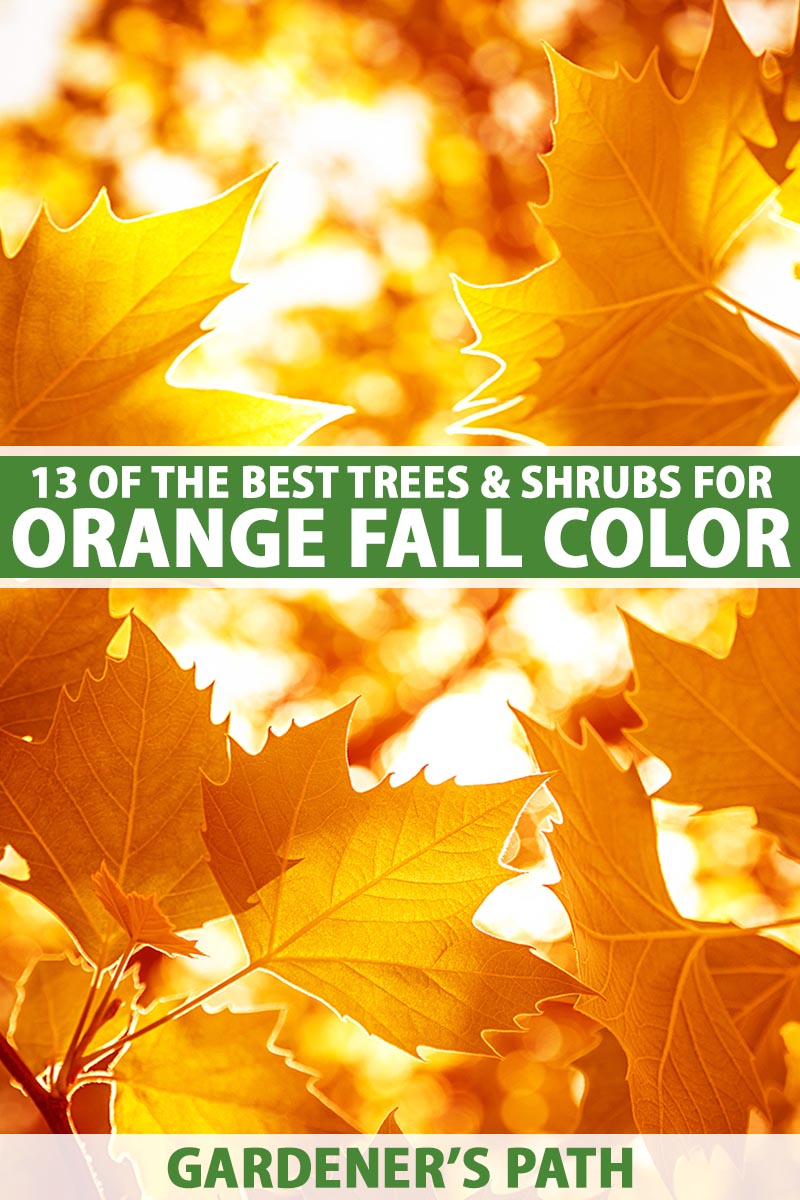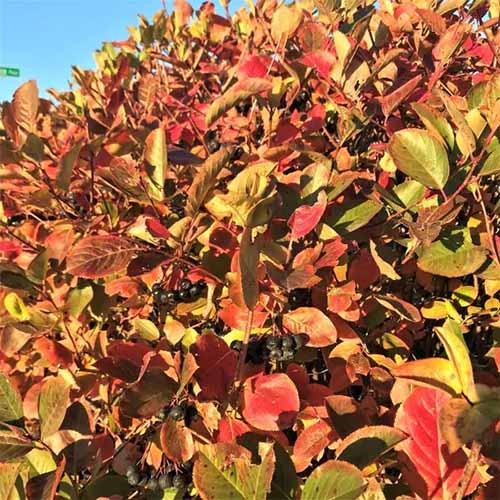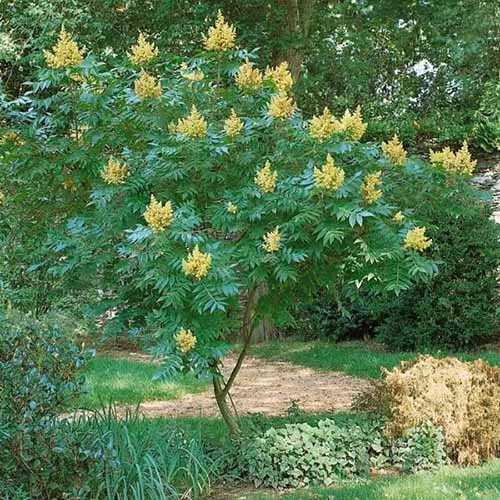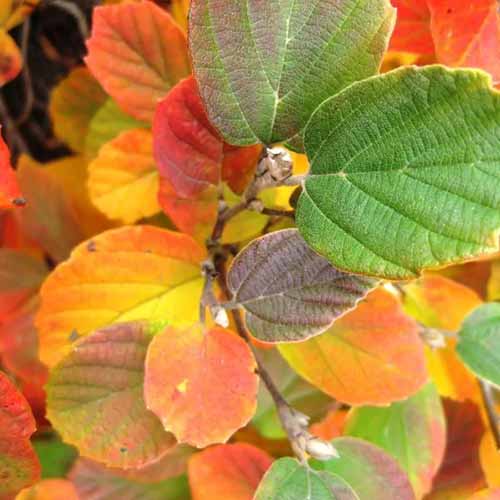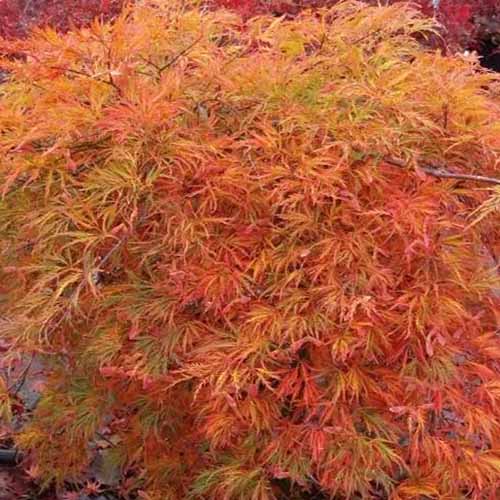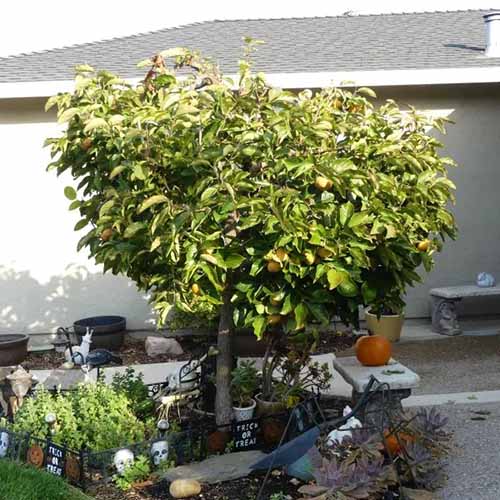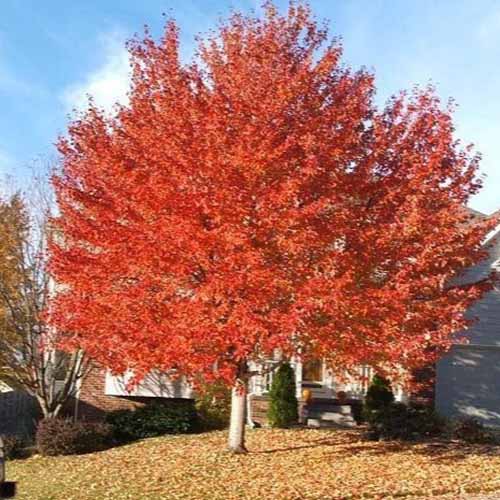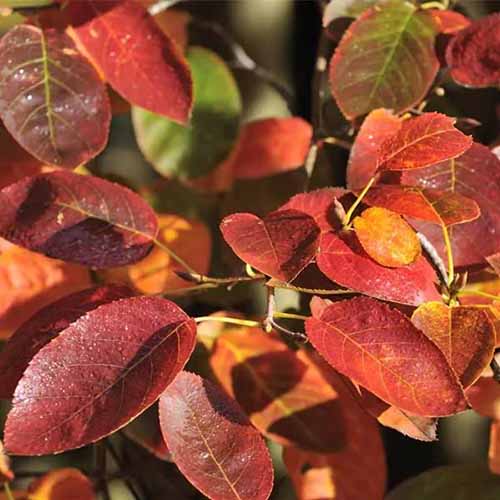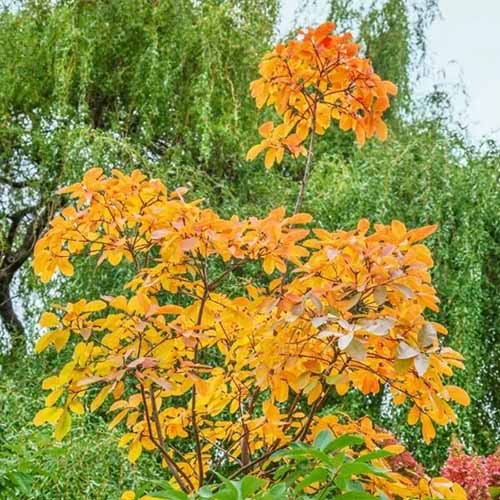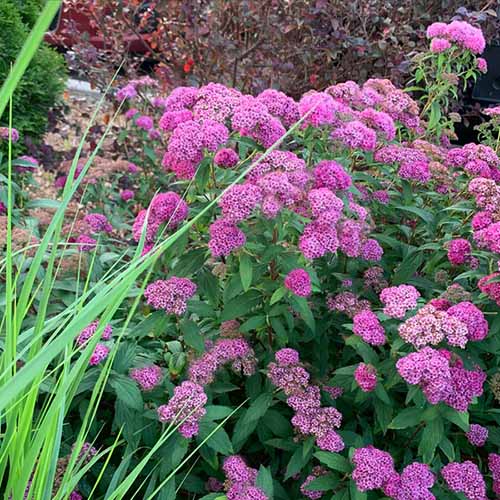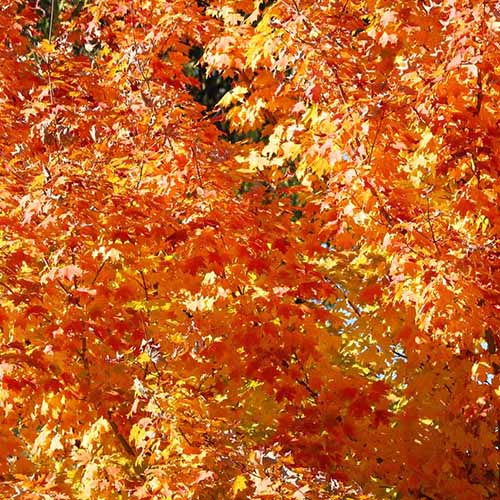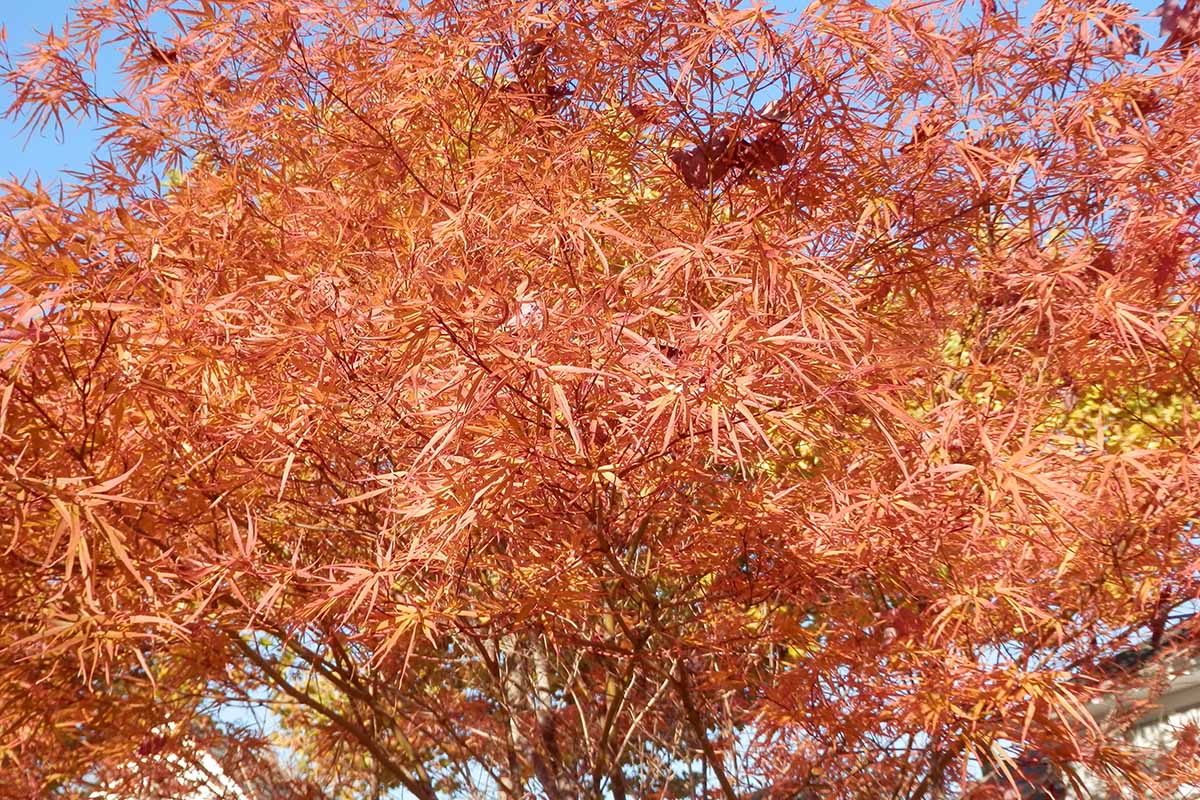We link to vendors to help you find relevant products. If you buy from one of our links, we may earn a commission. So for ideas and inspiration, it’s always a good idea to check out what gives a good showing in your neighborhood, local parks, and municipal plantings. And to get your Halloween on, have a look at our choice of 13 of the best trees and shrubs with outstanding orange fall colors! Here’s the lineup: The star-shaped leaves are a rich, glossy green, and in autumn, produce large swaths of intense colors in tones of burgundy, orange, purple, scarlet, and yellow. And the spiny seed pods are a favorite source of forage for songbirds, chipmunks, and squirrels. American Sweetgum Sweetgums are superb when planted in rows or as standalone specimens, and grow in an attractive, pyramid shape reaching 60 to 75 feet high and 40 to 50 feet wide. Trees are hardy in USDA Zones 5 to 9. American sweetgum is available in #3 containers at Nature Hills Nursery.
2. Black Chokeberry
Native to eastern North America, chokeberry (Aronia melanocarpa) is a rugged, tough, and durable clump-forming shrub providing three seasons of beautiful ornamental interest. The cultivar ‘Viking’ produces large clusters of showy white flowers in spring that develop into highly nutritious bunches of shiny black berries that ripen in late summer. And in fall, the glossy, dark green leaves give way to striking displays of deep burgundy, brilliant orange, purple, and vermillion. ‘Viking’ Black Chokeberry Shrubs have a tidy, upright, and rounded form, and grow three to six feet tall and wide. Hardy in Zones 3 to 9. ‘Viking’ can be found at Nature Hills Nursery in #3 containers.
3. Black Gum
Another native of eastern North America, the black gum (Nyssa sylvatica), aka black tupelo or sour gum, is terrific as a shade tree. The cultivar ‘Wildfire’ adds a unique twist with new foliage that emerges a striking ruby-red. Leaves stay bright red for weeks before maturing to a dark, glossy green over summer and finish the season with an incredible mixed palette of pumpkin orange, purple, scarlet and bright yellow. The delicate, nectar-rich blossoms that appear in May and June are a favorite of honeybees. In early fall, small black drupes form which provide an important food source for many birds, chipmunks, and squirrels. ‘Wildfire’ Black Gum The pyramidal to round trees grow to a mature height of 30 to 50 feet tall with a spread of 20 to 30 feet. Hardy in Zones 4 to 9. You can find ‘Wildfire’ available at Nature Hills Nursery in #2 and #3 containers.
4. Flameleaf Sumac
Sumacs (Rhus spp.) grow on every continent except Antarctica, but the tough North American native known as flameleaf or winged sumac (R. copallinum) gives the best, blazing hot fall colors. The tropical looking, slender-branched trees grow in small clusters, producing dense spires of creamy white, upright flowers throughout summer, attracting numerous pollinators. In fall, the narrow, serrated leaves glow in shades of fiery orange and flame red, and the reddish brown berries provide a winter food source for many songbirds. Flameleaf Sumac With an open, spreading growth habit, flameleaf sumac trees grow six to 12 feet high and 10 to 20 feet wide and are hardy in Zones 4 to 9. Native flameleaf sumac is available in #3 containers at Nature Hills Nursery.
5. Fothergilla
Fothergilla (Fothergilla major) is an easy-care, showy shrub with fragrant, honey-scented white flowers in spring that attract butterflies and hummingbirds. The cultivar ‘Mount Airy’ has an open, upright shape with leathery, blue-green foliage that takes on handsome tones of gold, orange, and reddish-purple as fall advances. ‘Mount Airy’ Fothergilla Excellent as specimen plants, these tidy shrubs grow five to six feet tall with a spread of four to five feet and are hardy in Zones 5 to 10. ‘Mount Airy’ shrubs can be found at Nature Hills Nursery.
6. Japanese Maple
Japanese maples (Acer palmatum) are tough and beautiful, with delicate, lacy leaves and cascading branches that give them a graceful, weeping form. And A. palmatum ‘Orangeola’ serves up a double helping of vivid colors. In spring, new foliage emerges as a flaming fire red that takes on deeper tones of green and maroon in summer – maroon in full sun with green in the shady underlayers. Fall brings another color change as the foliage first transitions into burgundy then finishes with a show of fiery orange. ‘Orangeola’ Japanese Maple Trees grow to a mature height of six to 10 feet with a similar spread, and are hardy in Zones 5 to 9. You can find one- to two- and three- to four-feet-tall ‘Orangeola’ plants at Planting Tree. You can learn more about Japanese maples and how to grow them in our guide.
7. Japanese Persimmon
With sweet, crunchy fruit that can be eaten straight from the tree, the Japanese, or Asian persimmon, Diospyros kaki ‘Fuyu’ has plenty of ornamental appeal as well. It features a handsome, open profile with a mature height of 18 to 20 feet and spread of 12 to 15 feet. In spring, fragrant white blossoms are highly attractive to many pollinators including butterflies and hummingbirds, and fruits mature to bright orange. Grown in full sun, the ovate foliage starts out a bright lime green that deepens over the summer, then produces exceptional fall finery in shades of brilliant orange and fiery reds. ‘Fuyu’ Japanese Persimmon Drought resistant once established, trees are hardy in Zones 7 to 10. ‘Fuyu’ is available at Nature Hills Nursery in #3 and #5 containers. Learn more about growing persimmons in our guide.
8. Red Sunset Maple
Red maples (Acer rubrum) are native to central and eastern North America. They are beloved for their spectacular fall colors, and are often the first to turn once cool temperatures arrive. Red Sunset, aka ‘Franksred’ is a fast growing cultivar that features shiny green leaves and strong, symmetrical branches that grow in a pyramidal shape. Uniform, deep tones of vibrant orange-red provide superior fall color. ‘Franksred’ Red Sunset Maple These iconic trees are beautiful for shade, growing 40 to 60 feet tall with a width of 25 to 35 feet. Hardy in Zones 4 to 8. ‘Franksred’ can be purchased at Planting Tree. Choose from five- to six-foot or six- to seven-foot specimens. Learn how to plant and grow red maples in our guide.
9. Serviceberry
A large, shrubby fruit tree, the serviceberry (Amelanchier), aka Juneberry, shadbush, and Saskatoon berry, gives three seasons of interest. Spring brings masses of pink buds opening to frothy white flowers that develop into tasty purple to black berries. Similar to blueberries, the early summer fruit provides a feast for songbirds and chipmunks. There are several native Amelanchier species throughout North America – and the natural hybrid ‘Autumn Brilliance’ (A. x grandiflora) dazzles with fall color. In autumn, the round, blue-green leaves give way to a glowing display of luminous amber, orange, and ruby red. ‘Autumn Brilliance’ Serviceberry These tough, hardy trees have an open, rounded shape and reach a height of 20 to 25 feet and spread of 15 to 20 feet. Hardy in Zones 3 to 9. ‘Autumn Brilliance’ is available at Nature Hills Nursery in a variety of sizes.
10. Shumard Oak
Tall and stately, the long-lived Shumard oak tree (Quercus shumardii) is native to eastern North America and renowned for its spectacular fall colors. A towering shade tree with a pyramidal shape, large acorns drop in fall and provide a prime foraging source for game birds, songbirds, chipmunks, squirrels, and other wildlife. In autumn, the dark green, lobed leaves finish the season with a fantastic display in tones of deep orange red and russet. Shumard Oak Highly adaptable for urban areas and landscapes, mature trees reach 75 to 90 feet high and spread 40 to 60 feet. Hardy in Zones 5 to 9. Shumard oaks are available in a variety of sizes at FastGrowingTrees.com.
11. Smoketree
Indigenous only to small pockets of central and southern USA, smoketree (Cotinus obovatus) is a whimsical and highly ornamental shrubby tree with some of the best fall colors. In spring, the leathery, egg-shaped foliage is a cool blue-green, and summer brings masses of wispy flowers, like bright red to mauvy-pink puffs of smoke. With the arrival of fall, the foliage ignites into a sensational mixed palette of coral orange, lemon yellow, lime, and raspberry. Smoketree The small, rounded trees grow 20 to 30 feet tall with a spread of 20 to 25 feet and the seeds feed numerous bird species. Hardy in Zones 4 to 8. Smoketree can be found at Nature Hills Nursery in #3 containers.
12. Spirea
Spirea shrubs are highly adaptable and versatile, with many cultivars providing fine fall colors. Spirea japonica ‘Little Princess,’ is a small shrub that makes an outstanding specimen plant or low border. Dreamy clusters of foamy pink flowers appear in late spring, and with regular deadheading, plants rebloom readily throughout summer. Summer’s light green leaves deepen in color as temperatures drop, then take on striking, burnished tones of coppery orange in fall. ‘Little Princess’ Spirea The rounded, spreading shrubs grow two to three feet tall with a width of four to five feet and are hardy in Zones 4 to 9. ‘Little Princess’ is available at Planting Tree in three-gallon containers. Learn more about how to grow spirea in our guide.
13. Sugar Maple
With fall colors as sweet as maple syrup, the sugar maple (Acer saccharum) is the primary tree used for syrup making, and it’s native to the hardwood forests of northeastern North America. Sugar maples make beautiful shade trees, with a handsome oval shape and dense crown, growing to a mature height of 60 to 75 feet and spreading 40 to 50 feet. Sugar Maple They can be grown in full to part sun, and in fall, the distinctive, five-lobed leaves put on a spectacular display in vibrant shades of burnt orange, red, and yellow. Hardy in Zones 3 to 8. Six- to seven-foot sugar maples are available at FastGrowingTrees.com. Maple Sugaring Kit And if you’d like to try your hand at making syrup, pick up a maple sugaring kit – like this one available at Lehman’s.
Bright, Bold, and Beautiful
From towering oaks to compact spirea, our selection of trees and shrubs are an excellent way to finish off the season with a bright, bold, and beautiful splash of orange foliage! Many make excellent shade trees and several provide an important foraging source of fruit, seeds, and nuts for birds and wildlife. Make a choice suitable for the size of your yard or landscape, then enjoy multiple seasons of interest as well as outstanding displays of autumn leaves. What are your favorite tree choices for splashy fall colors? Let us know in the comments section below. And for more landscape tree-growing knowledge, check out these guides next:
Why Leaves Change Color in FallCreate a Sustainable Landscape with Essential Native Trees and Shrubs for the Eastern USYour Fall Tree Planting Guide
